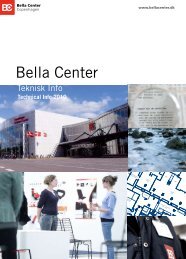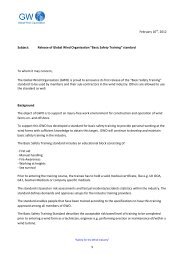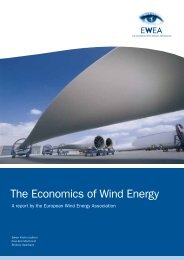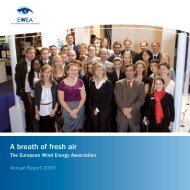Offshore Electricity Infrastructure in Europe - European Wind Energy ...
Offshore Electricity Infrastructure in Europe - European Wind Energy ...
Offshore Electricity Infrastructure in Europe - European Wind Energy ...
You also want an ePaper? Increase the reach of your titles
YUMPU automatically turns print PDFs into web optimized ePapers that Google loves.
for areas developed <strong>in</strong> the com<strong>in</strong>g ten years and<br />
2,000 MW for areas developed after 2020.<br />
• When differences <strong>in</strong> tim<strong>in</strong>g of construction exist<br />
between the w<strong>in</strong>d farms <strong>in</strong> a hub or when delays occur,<br />
it should be <strong>in</strong>vestigated whether a hub is still<br />
beneficial. Short delays or delays of smaller w<strong>in</strong>d<br />
farms generally do not impact the economics too<br />
much. However, governments should support simultaneous<br />
development as much as possible <strong>in</strong> order<br />
to reap the maximum benefits of the synergies of<br />
a comb<strong>in</strong>ed solution. <strong>Offshore</strong>Grid recommends<br />
assess<strong>in</strong>g hub solutions even for projects that are<br />
built with<strong>in</strong> time spans of more than 10 years.<br />
• National borders should not be a barrier for a hub<br />
connection solution. If for <strong>in</strong>stance a w<strong>in</strong>d farm<br />
is built close to the border and close to a w<strong>in</strong>d<br />
farm cluster <strong>in</strong> a neighbour<strong>in</strong>g country, it is recommended<br />
to construct cross border hub solutions.<br />
Regulatory frameworks, support scheme issues<br />
should allow these solutions.<br />
• In order to improve conditions for cross border<br />
meshed grid designs. <strong>Europe</strong>an Member States<br />
have to discuss how to distribute costs or fund<strong>in</strong>g<br />
<strong>in</strong>centives for jo<strong>in</strong>t <strong>in</strong>frastructure measures.<br />
Furthermore it has to be agreed to which country<br />
the renewable energy generated is credited.<br />
6.2 Tee-<strong>in</strong> solutions<br />
Key results on tee-<strong>in</strong> solutions<br />
• Connect<strong>in</strong>g an offshore w<strong>in</strong>d farm to an <strong>in</strong>terconnector<br />
by means of an underwater tee-jo<strong>in</strong>t is<br />
technically possible irrespective of whether the<br />
<strong>in</strong>terconnector itself uses HVDC CSC or VSC technology.<br />
For a configuration requir<strong>in</strong>g circuit breakers<br />
on a platform, VSC technology will become the preferred<br />
solution.<br />
• For reasons of operational security and fault handl<strong>in</strong>g,<br />
TSOs may generally prefer a solution with<br />
circuit breakers to reduce fault propagation. A full<br />
cost benefit analysis would be required to justify<br />
the additional cost and consequent reduction <strong>in</strong> net<br />
benefit <strong>in</strong>curred.<br />
46 As shown <strong>in</strong> Chapter 4, actual numbers are greatly dependent on case-specific parameters.<br />
<strong>Offshore</strong>Grid – F<strong>in</strong>al Report<br />
• Whether tee-<strong>in</strong> connection of offshore w<strong>in</strong>d farms<br />
to <strong>in</strong>terconnectors is beneficial depends on the<br />
associated constra<strong>in</strong>ts for <strong>in</strong>ternational power exchange<br />
and the substituted <strong>in</strong>frastructure costs.<br />
When connect<strong>in</strong>g an offshore w<strong>in</strong>d farm hub to an<br />
<strong>in</strong>terconnector, the availability of the <strong>in</strong>terconnector<br />
for <strong>in</strong>ternational exchange is reduced <strong>in</strong> the direction<br />
towards the country to which w<strong>in</strong>d farm was<br />
connected orig<strong>in</strong>ally (trade constra<strong>in</strong>t). On the other<br />
hand, <strong>in</strong>frastructure cost sav<strong>in</strong>gs <strong>in</strong>cur as the tee-<strong>in</strong><br />
is cheaper than the substituted <strong>in</strong>dividual connection,<br />
due to the fact that for the beneficial cases<br />
the cable length can be vastly reduced (w<strong>in</strong>d farm<br />
is far from shore but close to <strong>in</strong>terconnector).<br />
• Tee-<strong>in</strong> solutions become more beneficial when:<br />
– Price differences between countries are low<br />
as trade between the countries would then be<br />
secondary,<br />
– The w<strong>in</strong>d farm is far from shore and close to the<br />
<strong>in</strong>terconnector 46 ,<br />
– The country where the w<strong>in</strong>d farm is built usually<br />
has the lowest prices of the countries <strong>in</strong>volved,<br />
– The offshore w<strong>in</strong>d farm generation is <strong>in</strong>versely<br />
correlated with the price difference (high w<strong>in</strong>d<br />
power, low price difference),<br />
– The w<strong>in</strong>d farm capacity is either low compared<br />
to the <strong>in</strong>terconnector capacity (low trad<strong>in</strong>g constra<strong>in</strong>ts),<br />
or double its size (large <strong>in</strong>frastructure<br />
sav<strong>in</strong>gs); the economically worst case would be<br />
a w<strong>in</strong>d farm and <strong>in</strong>terconnector capacity of equal<br />
size,<br />
– A simple tee-jo<strong>in</strong>t is used <strong>in</strong>stead of an additional<br />
platform (fewer costs but no ability to break<br />
faults).<br />
• A special case, which can be considered to be a<br />
tee-<strong>in</strong> solution, has been identified for large w<strong>in</strong>d<br />
farms far from shore. Instead of connect<strong>in</strong>g the<br />
whole w<strong>in</strong>d farm to one shore, the connection can<br />
be split and the w<strong>in</strong>d farm can be connected to two<br />
shores.<br />
• This way, a w<strong>in</strong>d farm is connected and at the same<br />
time an <strong>in</strong>terconnector is built that can be used<br />
when the w<strong>in</strong>d farm is generat<strong>in</strong>g less than 50% of<br />
rated capacity, which occurs about 50-60% of the<br />
time.<br />
91









